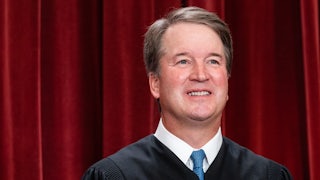What in the world could possibly bring the two of us together? One of us is a slightly reformed Reaganite, the other a slightly chastened social democrat, each of us mugged by authoritarianism. In the 1980s and 1990s, one of us worked for Ronald Reagan and George H.W. Bush; the other worked in the presidential campaigns of the Reverend Jesse Jackson Jr. and co-founded a progressive third party.
And yet, here we are, collaborating on a project that we believe can help restore the political health of the country we both love. What unites us is the understanding that our government is failing because politics is failing. At the heart of that political failure is a two-party system that pushes the citizenry into two hyperpolarized camps and discourages the coalitions and compromises essential to public problem-solving.
This is a systemic problem. It will not suddenly vanish even if, as is our shared hope, President Biden is reelected.
It’s a crisis familiar to most Americans. Substantial majorities tell pollsters that they want a way out of the “two-party doom loop.” But the solution is not a third party or independent presidential candidate: That always fails. At best they get a flurry of attention before fading into obscurity. A few are remembered, but only because they are seen, rightly or wrongly, as having played the role of a “spoiler.”
Still, the predictable failure of third-party candidates should not distract us from the need to solve the structural problems of the two-party system. The incentives baked into our system are in no small part responsible for bringing us to the precipice of authoritarianism.
What’s needed is a practical and achievable reform that pushes back against the hyperpartisan polarization that makes politics both juvenile and destructive. Partisanship itself is not bad—indeed it’s essential to a functioning democracy. But it has to be accompanied by rules and structures that incentivize positive-sum coalitions between parties. We’re stuck in a zero-sum world in which such coalitions are punished, not rewarded.
There is a way out, or at least a beginning of a way out. And the good news is that this path isn’t that complicated. We don’t need to invent something brand new. We need to revive fusion voting, which was commonplace in America throughout the nineteenth and into the early twentieth century. Fusion voting is the practice of a third party cross-nominating a candidate of one of the major parties. This candidate appears on the ballot under two different labels, with the votes tallied separately but then added together—fused—to determine their total.
In a fusion system, minor parties are both independent and relevant. They retain a “threat of exit” should neither major party nominate an acceptable candidate. More commonly, fusion parties will push or prod a major-party candidate to be better on a few key issues, and in return will nominate them. This is more constructive for the polity and more satisfying to the voter than a spoiler or wasted vote. “Vote for the candidate you prefer,” says the fusion party organizer, “under the party label closest to your values.”
Fundamentally, fusion voting produces more choices for the voter—but it’s more parties, not more candidates. The path out of the two-party doom loop runs not through eliminating or weakening parties but rather through a system that encourages and rewards coalitions between parties.
Once legal in every state, fusion voting is now largely forgotten. But there’s little doubt that fusion parties have played a constructive role in American history. Nearly all of the efforts to expand the meaning of “We, the People,” whether by abolitionists, farmers, workers, suffragists, prohibitionists, freedmen, silverites, or populists, involved fusion parties. Fusion allowed them to demonstrate that their views enjoyed meaningful support among the voters, which in turn allowed them to negotiate with their major-party ally.
No doubt the major parties disliked having to bargain with minor-party partners, but bargaining is essential in politics. The Whigs were mushy on slavery, and Free Soilers spined them up. Democrats were nervous about taking on the trusts, but the Populists insisted that they stand up for debtors and farmers. Fusion creates incentives for compromise between groups that do not agree on everything but do agree on enough to get things done.
Over time, fusion was outlawed by major-party leaders who could not resist the temptation to write rules in their own favor. It remains legal and common only in Connecticut and New York, where attempts to ban fusion failed. But imagine what a better position we’d be in as a country if we had these old rules in all states. A multiparty democracy could emerge, and it would surely include a centrist-minded fusion party that would moderate the current tendency toward polarization.
Such a party today could offer unhappy centrist voters a safe way to make a statement about problem solving and bipartisanship without risking splitting the anti-Trump voters and enabling the reelection of Trump. How? By endorsing the major-party candidate most committed to maintaining American democracy and then demonstrating to that candidate that a nontrivial percentage of voters want him to make good on the promise of moderation that got him the fusion party’s nomination. This could very well lead to the election of a critical mass of genuinely moderate, pro-democracy Republicans to the House of Representatives, whose presence could arrest and someday even reverse the GOP’s never-ending lurch to the right.
Fusion will not be legalized in time for the 2024 election, but there is progress toward its reemergence. In a few states, anti-Trump Republicans along with independents and some moderate Democrats are already trying to revive it—the New Jersey Moderate Party, the Common Sense Party in Michigan, and the just-launched United Kansas Party are harbingers. They each assert that they will not run stand-alone candidates with no chance of winning. Rather they propose to legalize fusion via litigation to overturn the various state bans as an unconstitutional abridgment of the freedom of association. If they succeed, these new fusion parties intend to cross-nominate major-party candidates who share their commitments to democracy, rule of law, and commonsense policymaking.
All Americans should hope they succeed. More broadly, we should make it a national project over the next few years to reintroduce fusion voting in many states. Otherwise, come 2028 we’ll be back in the exact same place—frustrated by a two-party system that polarizes and then artificially limits our choices. That is, assuming we still have a democratic election system come 2028.




